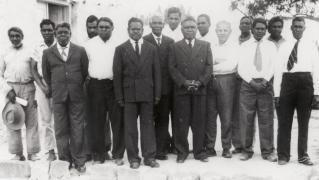F.W Albrecht entered the Lutheran mission institute at Hermannsburg, near Hanover, Germany, in 1913 but he was unable to complete his studies due to the outbreak of WW1. He served in the German medical corps on the Russian front and was awarded the Iron Cross for tending wounded soldiers under fire.1
After the war he returned to his missionary training at Hermannsburg in Germany, he completed his course in 1924 at which time he was asked to lead the Finke River Mission, Hermannsburg, Australia. Seven previous calls by the mission board for a missionary had gone unheeded.2
Before embarking for Australia, he spent five months in a seminary in the United States of America to improve his English. In Germany, he had met his future wife, Minna Maria Margaretha Gevers, and she joined him in Canada where they were married on 14 September 1925 at Winnipeg, Manitoba.
Arriving in Australia in October 1925, the newly married couple made their way to South Australia where Albrecht was ordained a pastor in the United Evangelical Lutheran Church of Australia on 14 February 1926. He arrived at Hermannsburg in April 1926. Like Carl and Frieda Strehlow, the Albrechts lived in the Missionary’s residence which is now the Kata Anga Tea Rooms
Some of the achievements of F.W Albrecht, while at Hermannsburg include 3:
- The construction of the Kuprilya pipeline and tank
- Training and ordination of Aboriginal evangelists
- The installation of pedal wireless by Alfred Traeger and Rev. John Flynn
- He opposed the removal of Aboriginal children from their families a fact which the people of Ntaria today credit with helping to keep their culture strong
- Development of a strong arts and craft industry at the Mission including the Central Australian watercolour school of landscape painting
- The establishment of a commercial tannery
- The divesting of key management jobs within the mission to Arrarnta people
Pastor Albrecht and his wife Minna left Hermannsburg in 1952 and moved to Alice Springs due to Minna’s deteriorating health. He continued to serve the Aboriginal people of the area.
While it would be misleading to say that Aboriginal people always agreed with him, Albrecht’s straight forward nature and his commitment to delivering what he promised earned him the respect of the Arrarnta people2. He became an assimilationist who believe that the only viable future for the Arrarnta people was integration into the modern world and he was less tolerant than Carl Strehlow of traditional practices and ceremonies.
- Schild, M 2007 Albrecht, Friedrich Wilhelm 1894–1984 Australian Dictionary of Biography, Volume 17, MUP.
- B. Henson, 1992 A Straight-Out Man
- Lohe, 1977 Hermannsburg: A Vision and a Mission
Media






